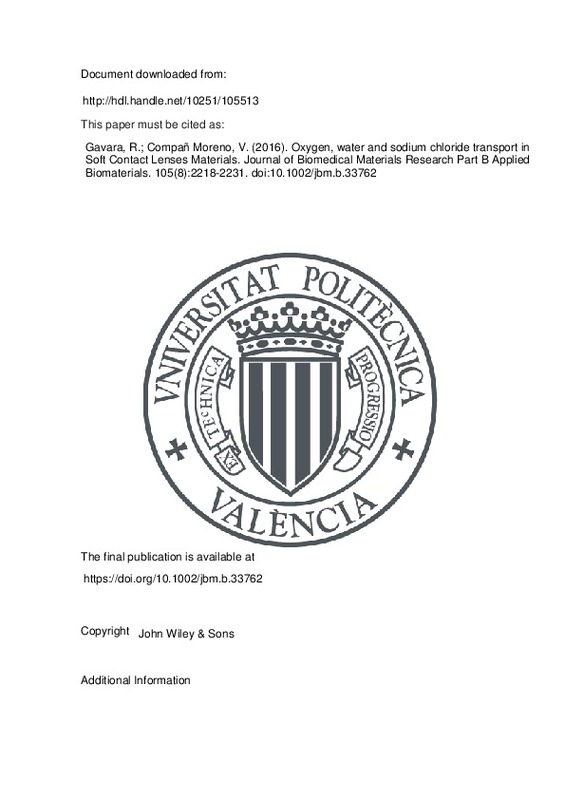JavaScript is disabled for your browser. Some features of this site may not work without it.
Buscar en RiuNet
Listar
Mi cuenta
Estadísticas
Ayuda RiuNet
Admin. UPV
Oxygen, water and sodium chloride transport in Soft Contact Lenses Materials
Mostrar el registro sencillo del ítem
Ficheros en el ítem
| dc.contributor.author | Gavara, Rafael
|
es_ES |
| dc.contributor.author | Compañ Moreno, Vicente
|
es_ES |
| dc.date.accessioned | 2018-07-09T04:28:13Z | |
| dc.date.available | 2018-07-09T04:28:13Z | |
| dc.date.issued | 2016 | es_ES |
| dc.identifier.issn | 1552-4973 | es_ES |
| dc.identifier.uri | http://hdl.handle.net/10251/105513 | |
| dc.description.abstract | [EN] Oxygen permeability, diffusion coefficient of the sodium ions and water flux and permeability in different conventional hydrogel (Hy) and silicone-hydrogel (Si-Hy) contact lenses have been measured experimentally. The results showed that oxygen permeability and transmissibility requirements of the lens have been addressed through the use of siloxane containing hydrogels. In general, oxygen and sodium chloride permeability values increased with the water content of the lens but there was a percolation phenomenon from a given value of water uptake mainly in the Si-Hy lenses which appeared to be related with the differences between free water and bound water contents. The increase of ion permeability with water content did not follow a unique trend indicating a possible dependence of the chemical structure of the polymer and character ionic and non-ionic of the lens. Indeed, the salt permeability values for silicone hydrogel contact lenses were one order of magnitude below those of conventional hydrogel contact lenses, which can be explained by a diffusion of sodium ions occurring only through the hydrophilic channels. The increase of the ionic permeability in Si-Hy materials may be due to the confinement of ions in nanoscale water channels involving possible decreased degrees of freedom for diffusion of both water and ions. In general, ionic lenses presented values of ionic permeability and diffusivity higher than most non-ionic lenses. The tortuosity of the ionic lenses is lower than the non-ionic Si-Hy lenses. Frequency 55 and PureVision exhibited the highest water permeability and flux values and, these parameters were greater for ionic Si-Hy lenses than for ionic conventional hydrogel lenses. | es_ES |
| dc.language | Inglés | es_ES |
| dc.publisher | John Wiley & Sons | es_ES |
| dc.relation.ispartof | Journal of Biomedical Materials Research Part B Applied Biomaterials | es_ES |
| dc.rights | Reserva de todos los derechos | es_ES |
| dc.subject | Hydrogel membranes | es_ES |
| dc.subject | Oxygen permeability | es_ES |
| dc.subject | Ionic permeability | es_ES |
| dc.subject | Water permeability | es_ES |
| dc.subject | Soft contact lenses | es_ES |
| dc.subject.classification | FISICA APLICADA | es_ES |
| dc.subject.classification | MAQUINAS Y MOTORES TERMICOS | es_ES |
| dc.title | Oxygen, water and sodium chloride transport in Soft Contact Lenses Materials | es_ES |
| dc.type | Artículo | es_ES |
| dc.identifier.doi | 10.1002/jbm.b.33762 | es_ES |
| dc.rights.accessRights | Abierto | es_ES |
| dc.contributor.affiliation | Universitat Politècnica de València. Departamento de Termodinámica Aplicada - Departament de Termodinàmica Aplicada | es_ES |
| dc.description.bibliographicCitation | Gavara, R.; Compañ Moreno, V. (2016). Oxygen, water and sodium chloride transport in Soft Contact Lenses Materials. Journal of Biomedical Materials Research Part B Applied Biomaterials. 105(8):2218-2231. doi:10.1002/jbm.b.33762 | es_ES |
| dc.description.accrualMethod | S | es_ES |
| dc.relation.publisherversion | https://doi.org/10.1002/jbm.b.33762 | es_ES |
| dc.description.upvformatpinicio | 2218 | es_ES |
| dc.description.upvformatpfin | 2231 | es_ES |
| dc.type.version | info:eu-repo/semantics/publishedVersion | es_ES |
| dc.description.volume | 105 | es_ES |
| dc.description.issue | 8 | es_ES |
| dc.relation.pasarela | S\324226 | es_ES |







![[Cerrado]](/themes/UPV/images/candado.png)

